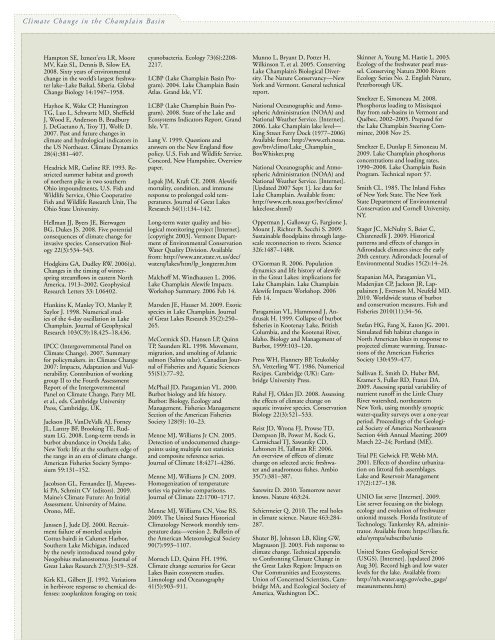Climate Change in the Champlain Basin - The Nature Conservancy
Climate Change in the Champlain Basin - The Nature Conservancy
Climate Change in the Champlain Basin - The Nature Conservancy
You also want an ePaper? Increase the reach of your titles
YUMPU automatically turns print PDFs into web optimized ePapers that Google loves.
<strong>Climate</strong> <strong>Change</strong> <strong>in</strong> <strong>the</strong> Champla<strong>in</strong> Bas<strong>in</strong>Hampton SE, Izmest’eva LR, MooreMV, Kaiz SL, Dennis B, Silow EA.2008. Sixty years of environmentalchange <strong>in</strong> <strong>the</strong> world’s largest freshwaterlake–Lake Baikal, Siberia. Global<strong>Change</strong> Biology 14:1947–1958.Hayhoe K, Wake CP, Hunt<strong>in</strong>gtonTG, Luo L, Schwartz MD, SheffieldJ, Wood E, Anderson B, BradburyJ, DeGaetano A, Troy TJ, Wolfe D.2007. Past and future changes <strong>in</strong>climate and hydrological <strong>in</strong>dicators <strong>in</strong><strong>the</strong> US Nor<strong>the</strong>ast. <strong>Climate</strong> Dynamics28(4):381–407.Headrick MR, Carl<strong>in</strong>e RF. 1993. Restrictedsummer habitat and growthof nor<strong>the</strong>rn pike <strong>in</strong> two sou<strong>the</strong>rnOhio impoundments, U.S. Fish andWildlife Service, Ohio CooperativeFish and Wildlife Research Unit, <strong>The</strong>Ohio State University.Hellman JJ, Byers JE, BierwagenBG, Dukes JS. 2008. Five potentialconsequences of climate change for<strong>in</strong>vasive species. Conservation Biology22(3):534–543.Hodgk<strong>in</strong>s GA, Dudley RW. 2006(a).<strong>Change</strong>s <strong>in</strong> <strong>the</strong> tim<strong>in</strong>g of w<strong>in</strong>terspr<strong>in</strong>gstreamflows <strong>in</strong> eastern NorthAmerica, 1913–2002. GeophysicalResearch Letters 33: L06402.Hunk<strong>in</strong>s K, Manley TO, Manley P,Saylor J. 1998. Numerical studiesof <strong>the</strong> 4-day oscillation <strong>in</strong> LakeChampla<strong>in</strong>. Journal of GeophysicalResearch 103(C9):18,425–18,436.IPCC (Intergovernmental Panel on<strong>Climate</strong> <strong>Change</strong>). 2007. Summaryfor policymakers. <strong>in</strong>: <strong>Climate</strong> <strong>Change</strong>2007: Impacts, Adaptation and Vulnerability.Contribution of work<strong>in</strong>ggroup II to <strong>the</strong> Fourth AssessmentReport of <strong>the</strong> IntergovernmentalPanel on <strong>Climate</strong> <strong>Change</strong>, Parry MLet al., eds. Cambridge UniversityPress, Cambridge, UK.Jackson JR, VanDeValk AJ, ForneyJL, Lantry BF, Brook<strong>in</strong>g TE, RudstamLG. 2008. Long-term trends <strong>in</strong>burbot abundance <strong>in</strong> Oneida Lake,New York: life at <strong>the</strong> sou<strong>the</strong>rn edge of<strong>the</strong> range <strong>in</strong> an era of climate change.American Fisheries Society Symposium59:131–152.Jacobson GL, Fernandez IJ, MayewskiPA, Schmitt CV (editors). 2009.Ma<strong>in</strong>e’s <strong>Climate</strong> Future: An InitialAssessment. University of Ma<strong>in</strong>e.Orono, ME.Janssen J, Jude DJ. 2000. Recruitmentfailure of mottled sculp<strong>in</strong>Cottus bairdi <strong>in</strong> Calumet Harbor,Sou<strong>the</strong>rn Lake Michigan, <strong>in</strong>ducedby <strong>the</strong> newly <strong>in</strong>troduced round gobyNeogobius melanostomus. Journal ofGreat Lakes Research 27(3):319–328.Kirk KL, Gilbert JJ. 1992. Variations<strong>in</strong> herbivore response to chemical defenses:zooplankton forag<strong>in</strong>g on toxiccyanobacteria. Ecology 73(6):2208-2217.LCBP (Lake Champla<strong>in</strong> Bas<strong>in</strong> Program).2004. Lake Champla<strong>in</strong> Bas<strong>in</strong>Atlas. Grand Isle, VT.LCBP (Lake Champla<strong>in</strong> Bas<strong>in</strong> Program).2008. State of <strong>the</strong> Lake andEcosystems Indicators Report. GrandIsle, VT.Lang V. 1999. Questions andanswers on <strong>the</strong> New England flowpolicy. U.S. Fish and Wildlife Service.Concord, New Hampshire. Overviewpaper.Lepak JM, Kraft CE. 2008. Alewifemortality, condition, and immuneresponse to prolonged cold temperatures.Journal of Great LakesResearch 34(1):134–142.Long-term water quality and biologicalmonitor<strong>in</strong>g project [Internet].[copyright 2003]. Vermont Departmentof Environmental ConservationWater Quality Division. Availablefrom: http://www.anr.state.vt.us/dec/waterq/lakes/htm/lp_longterm.htmMalchoff M, W<strong>in</strong>dhausen L. 2006.Lake Champla<strong>in</strong> Alewife Impacts.Workshop Summary. 2006 Feb 14.Marsden JE, Hauser M. 2009. Exoticspecies <strong>in</strong> Lake Champla<strong>in</strong>. Journalof Great Lakes Research 35(2):250–265.McCormick SD, Hansen LP, Qu<strong>in</strong>nTP, Saunders RL. 1998. Movement,migration, and smolt<strong>in</strong>g of Atlanticsalmon (Salmo salar). Canadian Journalof Fisheries and Aquatic Sciences55(S1):77–92.McPhail JD, Paragamian VL. 2000.Burbot biology and life history.Burbot: Biology, Ecology andManagement. Fisheries ManagementSection of <strong>the</strong> American FisheriesSociety 128(9): 10–23.Menne MJ, Williams Jr CN. 2005.Detection of undocumented changepo<strong>in</strong>tsus<strong>in</strong>g multiple test statisticsand composite reference series.Journal of <strong>Climate</strong> 18:4271–4286.Menne MJ, Williams Jr CN. 2009.Homogenization of temperatureseries via pairwise comparisons.Journal of <strong>Climate</strong> 22:1700–1717.Menne MJ, Williams CN, Vose RS.2009. <strong>The</strong> United States HistoricalClimatology Network monthly temperaturedata—version 2. Bullet<strong>in</strong> of<strong>the</strong> American Meteorological Society90(7):993–1107.Mortsch LD, Qu<strong>in</strong>n FH. 1996.<strong>Climate</strong> change scenarios for GreatLakes Bas<strong>in</strong> ecosystem studies.Limnology and Oceanography41(5):903–911.Munno L, Bryant D, Potter H,Wilk<strong>in</strong>son T, et al. 2005. Conserv<strong>in</strong>gLake Champla<strong>in</strong>’s Biological Diversity.<strong>The</strong> <strong>Nature</strong> <strong>Conservancy</strong>—NewYork and Vermont. General technicalreport.National Oceanographic and AtmosphericAdm<strong>in</strong>istration (NOAA) andNational Wea<strong>the</strong>r Service. [Internet].2006. Lake Champla<strong>in</strong> lake level—K<strong>in</strong>g Street Ferry Dock (1977–2006)Available from: http://www.erh.noaa.gov/btv/climo/Lake_Champla<strong>in</strong>_BoxWhisker.pngNational Oceanographic and AtmosphericAdm<strong>in</strong>istration (NOAA) andNational Wea<strong>the</strong>r Service. [Internet].[Updated 2007 Sept 1]. Ice data forLake Champla<strong>in</strong>. Available from:http://www.erh.noaa.gov/btv/climo/lakeclose.shtml)Opperman J, Galloway G, Fargione J,Mount J, Richter B, Secchi S. 2009.Susta<strong>in</strong>able floodpla<strong>in</strong>s through largescalereconnection to rivers. Science326:1487–1488.O’Gorman R. 2006. Populationdynamics and life history of alewife<strong>in</strong> <strong>the</strong> Great Lakes: implications forLake Champla<strong>in</strong>. Lake Champla<strong>in</strong>Alewife Impacts Workshop. 2006Feb 14.Paragamian VL, Hammond J, AndrusakH. 1999. Collapse of burbotfisheries <strong>in</strong> Kootenay Lake, BritishColumbia, and <strong>the</strong> Kootenai River,Idaho. Biology and Management ofBurbot, 1999:103–120.Press WH, Flannery BP, TeukolskySA, Vetterl<strong>in</strong>g WT. 1986. NumericalRecipes. Cambridge (UK): CambridgeUniversity Press.Rahel FJ, Olden JD. 2008. Assess<strong>in</strong>g<strong>the</strong> effects of climate change onaquatic <strong>in</strong>vasive species. ConservationBiology 22(3):521–533.Reist JD, Wrona FJ, Prowse TD,Dempson JB, Power M, Kock G,Carmichael TJ, Sawatzky CD,Lehtonen H, Tallman RF. 2006.An overview of effects of climatechange on selected arctic freshwaterand anadromous fishes. Ambio35(7):381–387.Sarewitz D. 2010. Tomorrow neverknows. <strong>Nature</strong> 463:24.Schiermeier Q. 2010. <strong>The</strong> real holes<strong>in</strong> climate science. <strong>Nature</strong> 463:284-287.Shuter BJ, Johnson LB, Kl<strong>in</strong>g GW,Magnuson JJ. 2003. Fish response toclimate change. Technical appendixto Confront<strong>in</strong>g <strong>Climate</strong> <strong>Change</strong> <strong>in</strong><strong>the</strong> Great Lakes Region: Impacts onOur Communities and Ecosystems.Union of Concerned Scientists, CambridgeMA, and Ecological Society ofAmerica, Wash<strong>in</strong>gton DC.Sk<strong>in</strong>ner A, Young M, Hastie L. 2003.Ecology of <strong>the</strong> freshwater pearl mussel.Conserv<strong>in</strong>g Natura 2000 RiversEcology Series No. 2. English <strong>Nature</strong>,Peterborough UK.Smeltzer E, Simoneau M. 2008.Phosphorus load<strong>in</strong>g to MissisquoiBay from sub-bas<strong>in</strong>s <strong>in</strong> Vermont andQuébec, 2002–2005. Prepared for<strong>the</strong> Lake Champla<strong>in</strong> Steer<strong>in</strong>g Committee,2008 Nov 25.Smeltzer E, Dunlap F, Simoneau M.2009. Lake Champla<strong>in</strong> phosphorusconcentrations and load<strong>in</strong>g rates,1990–2008. Lake Champla<strong>in</strong> Bas<strong>in</strong>Program. Technical report 57.Smith CL. 1985. <strong>The</strong> Inland Fishesof New York State. <strong>The</strong> New YorkState Department of EnvironmentalConservation and Cornell University,NY.Stager JC, McNulty S, Beier C,Chiarenzelli J. 2009. Historicalpatterns and effects of changes <strong>in</strong>Adirondack climates s<strong>in</strong>ce <strong>the</strong> early20th century. Adirondack Journal ofEnvironmental Studies 15(2):14–24.Stapanian MA, Paragamian VL,Madenjian CP, Jackson JR, Lappala<strong>in</strong>enJ, Evenson M, Neufeld MD.2010. Worldwide status of burbotand conservation measures. Fish andFisheries 2010(11):34–56.Stefan HG, Fang X, Eaton JG. 2001.Simulated fish habitat changes <strong>in</strong>North American lakes <strong>in</strong> response toprojected climate warm<strong>in</strong>g. Transactionsof <strong>the</strong> American FisheriesSociety 130:459–477.Sullivan E, Smith D, Huber BM,Kramer S, Fuller RD, Franzi DA.2009. Assess<strong>in</strong>g spatial variability ofnutrient runoff <strong>in</strong> <strong>the</strong> Little ChazyRiver watershed, nor<strong>the</strong>asternNew York, us<strong>in</strong>g monthly synopticwater-quality surveys over a one-yearperiod. Proceed<strong>in</strong>gs of <strong>the</strong> GeologicalSociety of America Nor<strong>the</strong>asternSection 44th Annual Meet<strong>in</strong>g; 2009March 22–24; Portland (ME).Trial PF, Gelwick FP, Webb MA.2001. Effects of shorel<strong>in</strong>e urbanizationon littoral fish assemblages.Lake and Reservoir Management17(2):127–138.UNIO list serve [Internet]. 2009.List server focus<strong>in</strong>g on <strong>the</strong> biology,ecology and evolution of freshwaterunionid mussels. Florida Institute ofTechnology. Tankersley RA, adm<strong>in</strong>istrator.Available from: https://lists.fit.edu/sympa/subscribe/unioUnited States Geological Service(USGS). [Internet]. [updated 2006Aug 30]. Record high and low waterlevels for <strong>the</strong> lake. Available from:http://nh.water.usgs.gov/echo_gage/measurements.htm)40
















